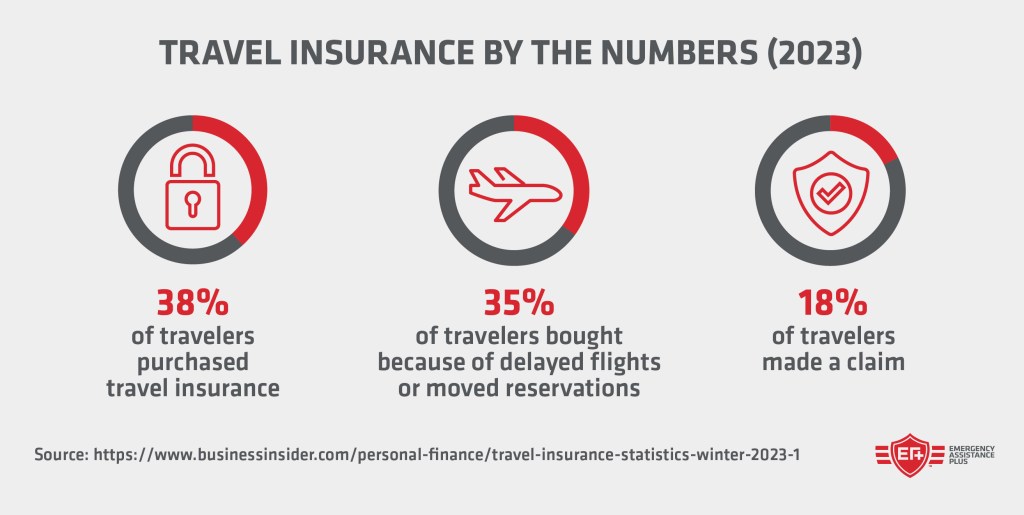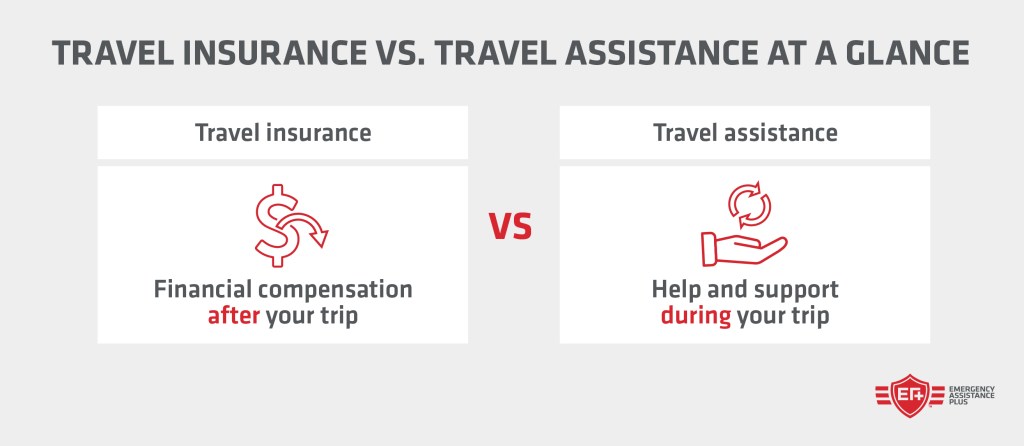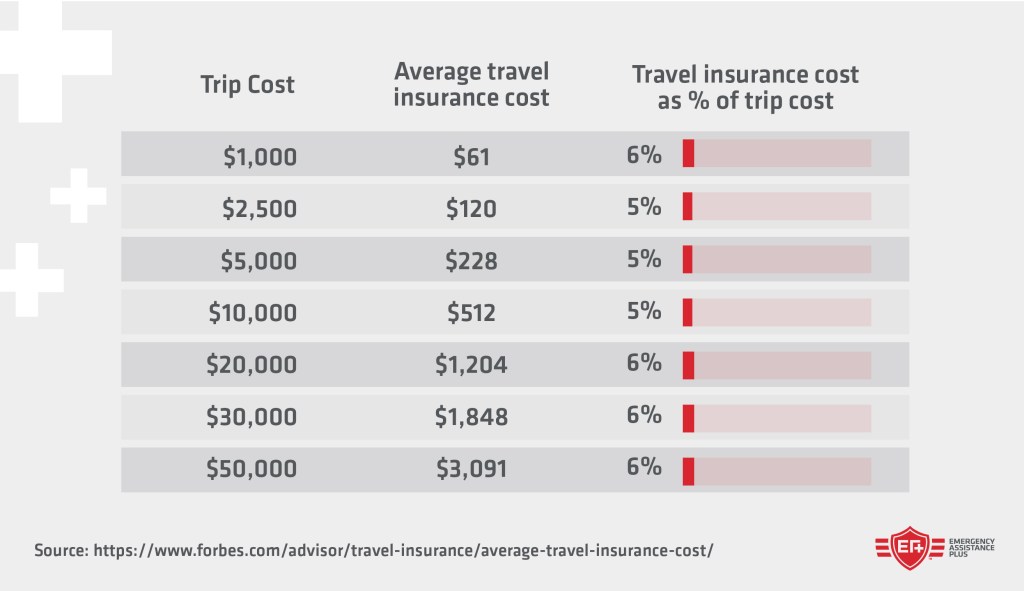Which meets your needs — travel insurance or travel assistance? Or both? Read the article to find out!
Published on July 20th, 2023 in Comparison, Travel Assistance, Travel Insurance
Smart travelers know that you have to take steps before a trip to ensure safety, maximize preparedness, and prevent financial loss.
There are many different options that can help you travel with confidence, but many people end up with the same question:
Should I get travel insurance or travel assistance?
While both of these products are designed to help travelers, they are actually very different in terms of their scope of services, their costs, and the situations where they’re most useful.
By understanding the differences between the two products and identifying where they overlap or complement each other, travelers can get the most out of their money while obtaining maximum protection.
In this article we’re going to focus on explaining the differences between travel insurance and travel assistance, discuss where they overlap, and examine when to use each.
Related reading:
What Is Travel Assistance?
How to Find Travel Assistance
Let’s start with some quick definitions.
What is travel insurance?
Travel insurance is a type of insurance that provides financial protection and coverage for various risks and incidents associated with traveling. It’s designed to mitigate potential financial loss and offer assistance in emergencies during your trip.
Business Insider conducted a survey in 2023 and found some interesting results:

What is travel assistance?
Travel assistance is a service that provides help individuals and families may need while traveling away from home. It’s designed to assist people during and after medical emergencies (and other travel-related issues) and is available 24 hours per day, 7 days per week, and 365 days per year. Travel assistance is not insurance—it is an annual membership program.
Coverage and services
To start, let’s take a look at the actual services you get with travel insurance vs. travel assistance and how they differ.
Travel insurance
Travel insurance usually offers financial protection against unforeseen circumstances such as trip cancellation, trip interruption, medical emergencies, lost or delayed baggage, and personal liability. The coverage and limits of travel insurance vary depending on the policy, provider, and the plan you choose.
There are many different types of travel insurance, but common examples include:
With travel insurance, the coverage is usually predetermined and outlined in the policy. You pay a premium upfront and receive coverage for the specified risks and incidents outlined in the policy for the specific trip you bought it for.
The vast majority of travel insurance plans are designed to compensate you financially after your trip by going through a claims process where they may or may not reimburse you.
Travel Assistance
Travel assistance services, on the other hand, focus more on providing immediate help and support during travel-related emergencies. This can include services like emergency medical assistance, emergency evacuation, translation services, and transportation home.
These services vary significantly depending on the travel assistance provider. For an example of a full list of travel assistance services, please check out the Emergency Assistance Plus plan page. Many plans cover the following:
Bottom line—Travel assistance is designed to give you on-demand support (24/7/365) in response to emergencies while you travel.

Cost structure
Now let’s discuss how costs are calculated for travel insurance vs. travel assistance.
Travel Insurance
Travel insurance premiums are typically calculated based on factors like trip duration, coverage limits, destination, and the traveler’s age. You pay the premium upfront before your trip, regardless of whether you use the coverage or not.
The cost of travel insurance fluctuates depending on the cost of the trip. Here are some average travel insurance costs expressed as a percentage of the total trip costs so you can get an idea of what you might pay:

Note: The costs in the graphic above represent the costs for a 30-year-old female. The average cost of travel insurance for a 68-year-old is likely closer to 10.5%.
The key thing to understand is that you buy travel insurance for a specific trip and the coverage is only valid for that trip.
Travel Assistance
The cost of travel assistance is generally much lower than comprehensive travel insurance and it typically has a different cost structure.
Many travel assistance providers, like EA+, offer their service as an annual membership. This means that you choose a plan, purchase, and then you have access to their services for every trip you take during one calendar year.
Note: Not all travel assistance works in the manner described above. Many have limitations on when or how often you can activate services. Unlike most travel assistance memberships, EA+ does not have limitations on how many trips you can take and still use the services.
We can’t speak to the costs for all travel assistance providers; however, pricing with EA+ is super simple:
EA+ offers two annual membership options, each with a flat-rate with all services included:
EA+ Essential: $209
EA+ Premier: $279
The rates above are for an individual membership, and this is where EA+ really shines from a cost perspective—with EA+ it’s only $60 more to protect your spouse or dependents with a family plan.
Claims process
An insurance claim is a request from the policyholder to the provider for payment after a covered incident. This is a standard practice for insurance—from car to home to travel insurance.
Travel Insurance
When you experience a covered event, you pay for the services out of pocket and then you file a claim with your travel insurance provider. The insurer will assess your claim, review the policy terms and conditions, and reimburse you for eligible expenses based on the coverage limits and deductibles.
This process is not without problems. According to Travelinsurance.com, around 10% of travel insurance claims are denied. This can happen when consumers do not read the fine print of their contracts and think they are covered for something, when they are not. Other common reasons for claim denial include:
Be sure to read your contract carefully and ask any questions you have before purchasing a travel insurance policy!
Travel Assistance
Travel assistance doesn’t have a claims process. Instead, you contact the travel assistance company via phone when you need help and they provide the required services according to your needs—simple. There are no out-of-pocket costs to the member and there aren’t any surprise bills, and so long as your request falls within the scope of your agreement, there also aren’t any negotiations.
When to use travel insurance vs. travel assistance
As we mentioned earlier, travel insurance primarily focuses on financial protection against unforeseen events, while travel assistance offers emergency transportation services and guidance during your trip.
You may want to consider purchasing both, since travel insurance and travel assistance do not have many overlapping services.
But there are a few common scenarios where one might be more useful.
For instance, if you’re concerned about your flight being canceled or delayed and want to receive compensation if that happens, travel insurance (specifically flight cancellation insurance) is nice to have.
If you’re apprehensive about an accident or health emergency during an RV trip, travel assistance from EA+ can get you the medical care you need and ensure your vehicle is returned home safely. Another key difference is that you can activate travel assistance services even if you do not have pre-made reservations. Most travel insurance requires pre-made reservations (like a flight) in order to be eligible for reimbursement. This makes travel assistance valuable for all types of travel, not just airplanes.
There are many travelers that like to have a year-round travel assistance plan for all the trips they take, and then add a travel insurance plan for a specific trip in which flights or non-refundable travel services are being purchased. If you’d like to speak with an expert about the benefits of a travel assistance membership, please feel free to give us a call at: 1-866-863-4460.

Should a medical emergency derail your travel, Emergency Assistance Plus® (EA+®) has you protected no matter where you are.
Enroll TodayRelated resources

Comparison
Wondering whether TSA PreCheck or Global Entry is right for you? Discover the key differences to choose the best Trusted Traveler program for your needs.
Continue Reading
Travel Insurance
Your honeymoon is a cherished experience. Protect it with the right travel insurance coverage, tailored to the unique needs of newlyweds.
Continue ReadingWE'VE GOT YOU COVERED
Emergency Assistance Plus provides you with protection anytime you travel. Whether you are thousands of miles away or merely a short road trip home, EA+ gives you the peace of mind knowing that should a medical emergency arise, a team of highly skilled medical professionals remain at the ready to ensure you receive proper medical care and are provided the necessary transportation home.
